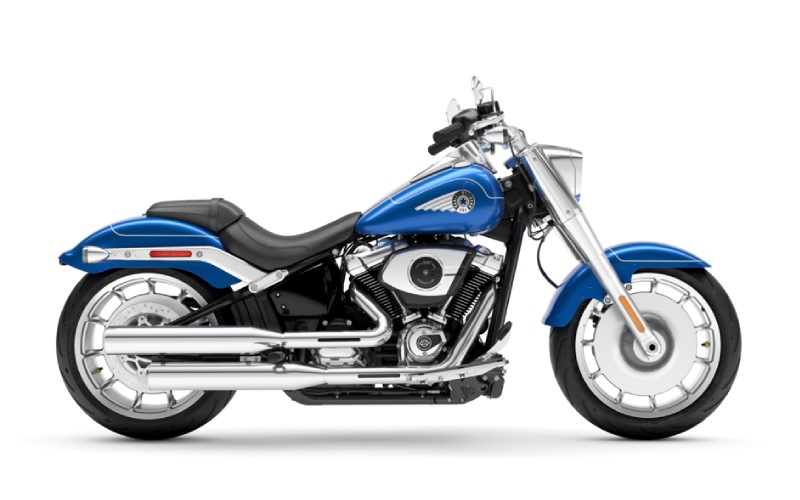Which 2025 Cruiser Suits Your Riding Style near Mason, OH - The 2025 Harley-Davidson® Fat Boy® or Low Rider® S?

Queen City Harley-Davidson® - Which 2025 Cruiser Suits Your Riding Style near Mason, OH - The 2025 Harley-Davidson® Fat Boy® or Low Rider® S?
Riders comparing these two heavy-hitting Cruisers often ask one big question: which platform best matches their riding style? The core difference lies in how each bike communicates with the road. One favors muscular stability and relaxed command; the other thrives on rapid transitions and high-rev engagement. This guide clarifies those dynamics so you can decide which style feels natural from your first mile.
The Fat Boy® sets the tone with broad-shouldered presence, polished chrome, and 18-inch Lakester wheels wrapped in massive rubber. It emphasizes planted composure, smooth power delivery, and long-haul comfort without muting the performance you expect from a Milwaukee-Eight 117. The Low Rider® S flips the script with a tall rear monoshock for extra cornering clearance, a Heavy Breather intake, a focused two-into-one exhaust, LED lighting, and a steep-backed solo seat that braces you under acceleration. Both add Ride Modes, Traction Control, USB-C charging, and updated hand controls, so you get modern capability regardless of which speaks to you. Queen City Harley-Davidson® is serving Mason, Batavia, and Dayton with a knowledgeable team ready to align you with a bike that suits your routes and goals.
- Riding posture: The Fat Boy® offers an open, neutral stance for relaxed cruising; the Low Rider® S rotates weight slightly forward for a more assertive, performance-ready posture.
- Cornering character: The Fat Boy® favors smooth, stable arcs; the Low Rider® S uses its tall rear monoshock to increase lean clearance and quicken transitions.
- Engine feel: Both use Milwaukee-Eight 117 power, but the Fat Boy® emphasizes torque-rich roll-ons while the Low Rider® S revs eagerly higher in the range.
- Sound and flow: Fat Boy® runs a high-flow two-into-two exhaust for a classic pulse; Low Rider® S uses a two-into-one for compact mass and sharp response.
- Tech interface: Each delivers analog gauges with a digital window for Ride Modes and device-friendly USB-C charging.
For riders commuting across suburbs or threading weekend traffic, the Fat Boy®’s broader footprint can translate to a calmer cadence—stable off the line, settled over freeway seams, and unflappable on sweeping connectors. If your favorite roads include elevation changes, decreasing-radius turns, or tight S-curves, the Low Rider® S returns that investment with higher cornering potential and a chassis that enjoys being loaded and released. In short, choose by the rhythm you crave: the Fat Boy® flows; the Low Rider® S attacks.
Both models bring comparable safety and convenience features. Ride Modes and Traction Control optimize response to surface and weather changes, while Cruise Control and an adjustable brake lever on each platform reduce fatigue across longer days. The Fat Boy®’s five-inch analog display and the Low Rider® S’s riser-mounted four-inch gauge keep information simple and legible, and the USB-C port supports navigation, music, and communications through a Bluetooth headset. Your decision is less about features and more about how you want those features expressed on your ideal road.
Frequently Asked Questions:
What’s the primary ergonomic difference between the two?
The Fat Boy® places you in a relaxed, open triangle that encourages smooth, commanding cruising, while the Low Rider® S uses a slightly more forward-leaning stance and a steep-backed solo seat to support hard acceleration and quick direction changes.
How do their exhaust systems influence character?
The Fat Boy® uses a high-flow two-into-two exhaust that reinforces classic cruiser rhythm and balanced feel; the Low Rider® S runs a compact two-into-one that tightens mass, sharpens response, and encourages higher revs.
Do both bikes include modern rider aids?
Yes. Both include Ride Modes, Traction Control, Cruise Control, an adjustable brake lever, and USB-C charging, integrating technology for comfort and control without distracting from the ride.
Which model is better for frequent corner carving?
The Low Rider® S. Its tall rear monoshock provides extra cornering clearance and a chassis feel tuned for riders who want to lean deeper and transition faster between turns.
Which model is more comfortable for extended highway runs?
The Fat Boy®. Its updated monoshock prioritizes comfort, the stance feels planted at speed, and the overall posture supports relaxed, confidence-inspiring miles.
How should I decide between them for daily use?
Think about your routes and preferences: if your day-to-day riding calls for stable composure and an iconic cruiser feel, the Fat Boy® is compelling; if you crave sharper feedback and higher cornering performance on familiar roads, the Low Rider® S fits the bill.
Ultimately, both Cruisers deliver modern tech, Milwaukee-Eight 117 power, and authentic style. Your perfect match is the one that mirrors the way you ride most often—whether you keep it smooth and steady or push for precision on every corner.

